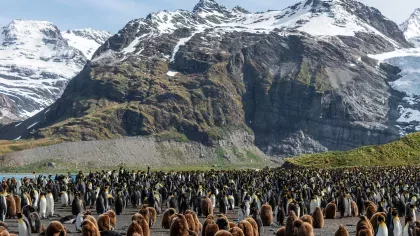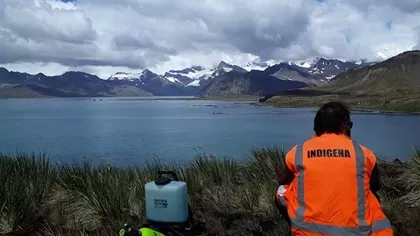Securing South Georgia’s native habitats
Monitoring vegetation changes, quantifying the soil seed bank, and assessing seed dispersal following non-native species control to inform native plant and habitat management on the sub-Antarctic island of South Georgia.

Project Leader and Manager
Kew
Dr Colin P Clubbe
Marcella Corcoran
Kaitalin White
Indigena Biosecurity International
Bradley Myer
Kelvin Floyd
Sally Poncet
Ken Passfield
Pamela Quilodrán
Jörg Kluge
Durham University
Dr Wayne Dawson
Invasive non-native species are one of the most important drivers of biodiversity loss globally, and this impact is particularly severe on islands. The sub-Antarctic island of South Georgia is part of the UK Overseas Territory of South Georgia and the South Sandwich Islands and located in the Southern Atlantic Ocean. South Georgia is a wildlife haven which has, until recently, been significantly impacted by introduced reindeer and rodents. Reindeer were successfully removed in 2014 and the island was declared rodent free in May 2018.
In response to the predicted grazing pressure release following mammal eradication, a non-native plant management strategy was developed by the Government of South Georgia and the South Sandwich Islands (GSGSSI) and is now being implemented. This programme aims to manage to zero density 33 of the 41 non-native species on the island and to control the spread of the more widespread invasive species. Eradication of non-native plant species is exceedingly difficult because of the formation of a soil seed bank from which plants regenerate, often for many years.
In support of the South Georgia Non-Native Plant Management Strategy, this project is: assessing the effectiveness of non-native plant eradication efforts, estimating the risk of non-native plant species persisting past 2020 to inform future management activities, quantifying the potential for non-native plant species to spread into new areas exposed by retreating glaciers, and ensuring native plant species of South Georgia are secured in ex-situ conservation.
The project is safeguarding South Georgia’s native habitats and informing future management strategy by:
- Monitoring vegetation changes following invasive non-native species control and assessing the effectiveness of non-native plant eradication efforts;
- Estimating the risk of non-native plant species persisting past 2020 from soil seed bank and seed viability studies;
- Quantifying the potential for non-native plant species to disperse into new areas following glacial retreat due to climate change; and,
- Collecting seed and fern spores of native plant species for conservation at Kew’s Millennium Seed Bank.
The Darwin Initiative DPLUS080
Resources
South Georgia Non-Native Plant Management Strategy
Field Guide to the Introduced Flora of South Georgia
Follow @KewUKOTs
Search #KewSouthGeorgia

